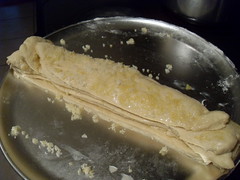
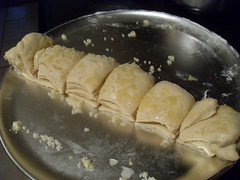
The method of making the dough was different this time. Instead of adding all of the flour in at once, I reserved some to be put in towards the end after the wet ingredients have been mixed in. I've seen this method on other blogs even for the cinnamon sugar version and thought it wouldn't make a difference. I don't think it showed in the end result, but I liked adding flour that wasn't more than necessary after adding the wet ingredients.
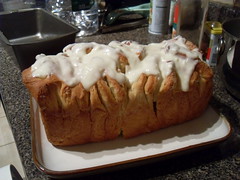
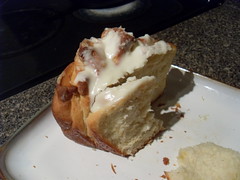
Look at how much is gone within 12 hours! It's that good. Not overly sweet, not overly citrus-y. A great balance of refreshing flavors. The cream cheese glaze adds a nice tangy kick to each bite. Again, I don't have a stand mixer with dough paddle or anything, but was still able to make this cake. My arm just got a nice workout.
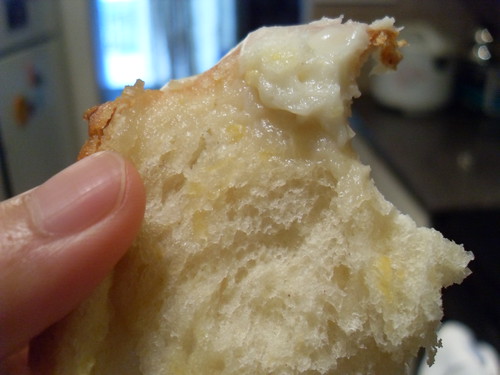
Specks of zest throughout. Delicious. I didn't have oranges, so I left out the orange zest, but still great. I noticed that 30 minutes wasn't enough when I baked the cinnamon sugar version the first around as the inside was still doughy, so I baked for 5 more minutes and it was perfect! Make sure you cover the bread with foil though so that the top doesn't burn.
Lemon Pull-Apart Coffee Cake
From Leite's Culinaria
For the sweet yeast dough
2 3/4 cups (12 1/4 oz) all-purpose flour
1/4 cup (1 3/4 oz) granulated sugar
2 1/4 tsp (1 envelope) instant yeast
1/2 tsp salt
1/3 cup (2 1/2 fl oz) whole milk
2 oz unsalted butter
1/4 cup (2 fl oz) water
1 1/2 tsp pure vanilla extract
2 large eggs, at room temp
For the lemon paste filling
1/2 cup (3 1/2 oz) granulated sugar
3 tbsp finely grated lemon zest (3 lemons)
1 tbsp finely grated orange zest
2 oz unsalted butter, melted
For the tangy cream cheese icing
3 oz cream cheese, softened
1/3 cup (1 1/4 oz) powdered sugar
1 tbsp whole milk
1 tbsp fresh lemon juice
Stir together 2 cups (9 oz) of flour, sugar, yeast, and salt in a bowl of a stand mixer; set aside. In a small saucepan, heat the milk and butter over low heat just until the butter is melted. Remove from heat, add the water, and set aside until warm (120F to 130F), about 1 minute. Add vanilla extract.
Pour milk mixture over flour-yeast mixture and, using a rubber spatula, mix until the dry ingredients are evenly moistened. Attach the bowl to the mixer, and fit the mixer with the paddle attachment. With the mixer on low speed, add the eggs, one at a time, mixing after each addition just until incorporated. Stop the mixer, add 1/2 cup (2 1/4 ounces) of the remaining flour, and resume mixing on low speed until the dough is smooth, 30 to 45 seconds. Add 2 more tbsp flour and mix on medium speed until the dough is smooth, soft, and slightly sticky, about 45 seconds.
Sprinkle a work surface with 1 tbsp flour and center the dough on the flour. Knead gently until smooth and no longer sticky, about 1 minute, adding an additional 1 to 2 tablespoons flour only if necessary to lessen the stickiness. Place the dough in a large bowl, cover the bowl securely with plastic wrap, and let the dough rise in a warm place until doubled in size, 45 to 60 minutes. Press the dough gently with a fingertip. If the indentation remains, the dough is ready for the next step.
While the dough is rising, make the filling. In a small bowl, mix together the sugar and the lemon and orange zests. Set the sandy-wet mixture nearby (the sugar draws out moisture from the zests to create the consistency).
Center a rack in the oven and preheat the oven to 350F. Lightly butter a 9-by-5-by-3-inch loaf pan. Or, lightly coat the pan with nonstick spray. Gently deflate the dough. On a lightly floured work surface, roll out the dough into a 20-by-12-inch rectangle. Using a pastry brush spread the melted butter generously over the dough. Cut the dough crosswise into 5 strips, each about 12 by 4 inches. (A pizza cutter is helpful here.) Sprinkle 1 1/2 tbsp of the zest-sugar mixture over one of the buttered rectangles. Top with a second rectangle and sprinkle it with 1 1/2 tbsp of the zest-sugar mixture. Repeat with the remaining dough rectangles and zest-sugar mixture, ending with a stack of 5 rectangles. Work carefully when adding the crumbly zest filling, or it will fall off when you have to lift the stacked pastry later.
Slice the stack crosswise through the 5 layers to create 6 equal strips, each about 4 by 2 inches. Fit these layered strips into the prepared loaf pan, cut edges up and side by side. Loosely cover the pan with plastic wrap and let the dough rise in a warm place until puffy and almost doubled in size, 30 to 50 minutes. Press the dough gently with a fingertip. If the indentation remains, the dough is ready for baking.
Bake the coffee cake until the top is golden brown, 30 to 35 minutes. Transfer to a wire rack and let cool in the pan for 10 to 15 minutes.
Meanwhile, make the cream cheese icing. In a medium bowl, using a rubber spatula, vigorously mix the cream cheese and sugar until smooth. Beat in the milk and lemon juice until the mixture is creamy and smooth.
To remove the coffee cake from the pan, tilt and rotate the pan while gently tapping it on a counter to release the cake sides. Invert a wire rack on top of the coffee cake, invert the cake onto the rack, and carefully lift off the pan. Invert another rack on top, invert the cake so it is right side up, and remove the original rack. Slip a sheet of waxed paper under the rack to catch any drips from the icing. Using a pastry brush, coat the top of the warm cake with the icing to glaze it. (Cover and refrigerate the leftover icing for another use. It will keep for up to 2 days.)
Serve the coffee cake warm or at room temperature. To serve, you can pull apart the layers, or you can cut the cake into 1-inch-thick slices on a slight diagonal with a long, serrated knife. If you decide to cut the cake, don’t attempt to cut it until it is almost completely cool.

No comments:
Post a Comment